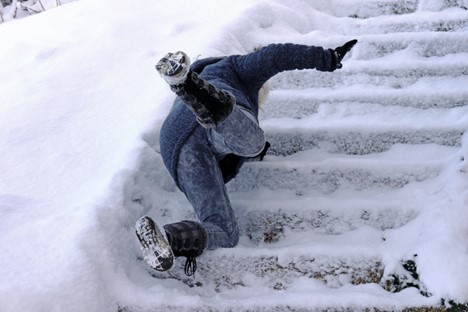Avoiding Slips, Trips, and Falls in Winter Weather
During icy and snowy conditions, the incidence of injuries due to slips and falls increases. Below are a number of suggestions which, if followed, can reduce the number of slips and falls or reduce injury if a fall occurs. Please read them carefully. Also, remember to dress in appropriate attire.
TO AVOID SLIPS:
1) Concentrate on the path ahead — take your time and proceed slowly.
2) Where possible, avoid slippery surfaces — take a route around obvious slippery
hazards, such as wet leaves, icy areas and snow banks.
3) Wear appropriate footwear — wear shoes or boots with rough (waffled, ridged or
heavily textured) soles to work and change into dress shoes if you must wear them. The
inconvenience of changing shoes is insignificant compared to the inconvenience due to a
serious fall related injury.
4) Use handrails wherever they are provided — a secure handhold can prevent a fall if
you should slip.
5) Check to be sure entrance halls and stairs are clear of snow and slush — tracked in
snow and slush often cause slips and falls.
6) Beware of changes in walking surfaces — many falls are caused when someone doesn’t
realize he/she is leaving a secure area for a slippery one.
7) Clean your shoes when you go inside — caked snow and ice on shoe soles can be
treacherous.
IF YOU SLIP:
1) Try to /roll with the fall/ if you begin to fall forward.
2) Sit down if you begin to fall backward — when a falling person relaxes, an injury is less severe than when he/she tenses. Fighting a fall on ice can cause twisting or bending injuries which may be worse than the bump the fall would have produced.
A few precautions can prevent a serious and painful injury!
Evan K. Rowe, Jr. Ph.D.
Safety Director
Occupational Safety & Health Department



